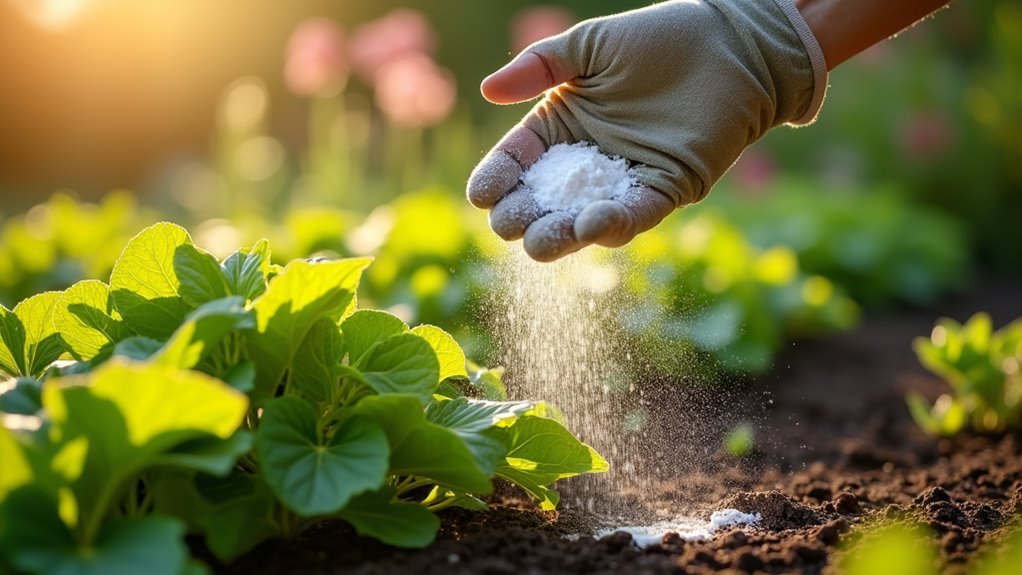You’ll achieve maximum pest control by applying diatomaceous earth during early morning when insects are most active and conditions are dry. Target evening applications to protect beneficial pollinators, focusing on damaged areas rather than flowers. Apply after rain for better soil penetration, but guarantee 24-48 hours of dry conditions follow. Maintain temperatures between 70-90°F, humidity below 50%, and wind speeds under 5 mph. Reapply every 3-4 weeks during active pest seasons for continued effectiveness, following these strategic timing principles to reveal ideal results.
Early Morning Application for Maximum Pest Contact

When you apply diatomaceous earth in the early morning hours, you’ll maximize your pest control effectiveness by targeting insects during their most active period.
This early morning application timing takes advantage of dry conditions, preventing the powder from clumping and maintaining its desiccating properties. You’ll find ants and fleas foraging during these hours, making it perfect for placing diatomaceous earth directly in their travel paths for maximum pest contact.
Morning applications also minimize wind dispersal, keeping the fine powder localized where pests encounter it most.
When you apply diatomaceous earth early, the residual effects remain active throughout the day, creating an effective pest elimination strategy before afternoon humidity reduces its potency.
Evening Treatment to Protect Beneficial Insects
While morning applications target peak pest activity, evening treatments offer a strategic advantage for protecting beneficial insects that play essential roles in your garden ecosystem.
Evening applications of diatomaceous earth reduce harm to pollinators like bees and ladybugs since they’re less active during twilight hours. You’ll want to avoid applying DE directly on flowers and top leaves where beneficial insects make contact.
Evening DE applications protect beneficial pollinators like bees and ladybugs by avoiding direct contact with flowers during their active hours.
Instead, focus treatments on areas showing visible pest damage rather than broadcasting throughout your entire garden. Evening timing allows the DE to settle overnight, creating effective pest barriers without disrupting pollinator activity.
Monitoring local pollinator activity and weather conditions helps you determine ideal application windows that maximize pest control while minimizing ecological impact on your garden’s helpful inhabitants.
Post-Rain Application for Enhanced Soil Penetration

You’ll find that applying diatomaceous earth after rainfall creates ideal moisture conditions that help the powder adhere better to surfaces and penetrate deeper into soil.
This timing strategy maximizes soil absorption benefits, as the DE settles into areas where pests burrow while simultaneously improving soil aeration and drainage for healthier plants.
Understanding proper reapplication timing guidelines guarantees you won’t waste product by applying too soon after heavy rain or during overly saturated conditions.
Optimal Moisture Conditions
Although diatomaceous earth works effectively in dry conditions, applying it after rainfall creates ideal circumstances for enhanced soil penetration and pest control.
The best moisture conditions allow DE particles to settle deeper into soil crevices where pests actively hide and breed. Wet surfaces also improve adherence, ensuring your application stays where you need it most.
Here’s how to maximize effectiveness under best moisture conditions:
- Apply immediately after rain stops – Moist soil allows better penetration while maintaining particle integrity
- Target pest hiding spots – Wet conditions help DE stick to cracks, crevices, and plant surfaces
- Wait for partial drying – DE becomes fully effective as moisture dissipates naturally
- Reapply within 72 hours – Maintain consistent coverage for continued pest control protection
Soil Absorption Benefits
Post-rain diatomaceous earth applications deliver three key soil absorption advantages that transform your pest control strategy into a thorough soil improvement system.
The moisture from recent rainfall acts as a binding agent, helping DE adhere directly to soil particles and penetrate deeper layers where beneficial minerals can take effect. This enhanced soil absorption dramatically improves effectiveness by preventing surface runoff and keeping the material exactly where you need it most.
You’ll notice improved water retention and better soil aeration when DE mixes with moist earth, creating ideal conditions for healthier root development.
The moisture also increases DE’s longevity by preventing wind dispersal and washaway, ensuring your pest control investment delivers maximum long-term value.
Reapplication Timing Guidelines
The effectiveness of your diatomaceous earth pest control depends entirely on strategic reapplication timing that maximizes soil penetration while maintaining protective barriers.
Moisture considerably diminishes DE’s pest control properties, making post-rain reapplication critical for maintaining protection.
Optimal Reapplication Timing Guidelines:
- Wait 24-48 hours after rain to guarantee complete ground drying before reapplying diatomaceous earth.
- Monitor weather forecasts regularly to plan reapplication during predicted dry spells for maximum effectiveness.
- Apply light dustings in dry conditions to enhance soil penetration and create stronger pest barriers.
- Schedule routine reapplication every 3-4 weeks during active pest seasons, particularly following heavy dew or rainfall.
Strategic reapplication timing guarantees your diatomaceous earth maintains consistent protective coverage against pest infestations throughout changing weather conditions.
Dry Weather Windows for Optimal Effectiveness

When you’re planning to apply diatomaceous earth, timing your application with dry weather windows becomes essential for achieving maximum pest control effectiveness.
You’ll want to choose windless days when no rain is forecast for at least 24 to 48 hours. This makes certain the powder stays dry and maintains its pest-killing properties.
Apply diatomaceous earth during early morning or late afternoon when temperatures are cooler and wind conditions are minimal.
These timing strategies prevent the powder from being dispersed by weather conditions before it can work effectively.
Monitor weather patterns continuously, as moisture from rainfall or heavy dew will deactivate your application of diatomaceous earth.
You’ll need reapplication after wet conditions to restore your pest management program’s effectiveness.
Seasonal Timing Based on Pest Life Cycles
You’ll achieve maximum pest control effectiveness by timing your diatomaceous earth applications to coincide with key moments in pest life cycles.
Spring represents the critical window when many insects emerge from dormancy and begin reproducing, making early intervention essential for preventing population explosions.
Fall presents another strategic opportunity as pests seek shelter for overwintering, allowing you to create protective barriers before they establish themselves in your home.
Spring Emergence Patterns
As temperatures rise and soil begins to warm, countless dormant pests stir from their winter hideouts and start their active cycles.
Spring marks a critical window for natural pest control using diatomaceous earth, as insects like ants, fleas, and garden pests become increasingly active. You’ll achieve maximum effectiveness by timing your application strategically with these emergence patterns.
Spring Application Strategy:
- Monitor temperature thresholds – Apply diatomaceous earth when soil temperatures consistently reach 50-60°F, signaling pest awakening.
- Target pre-emergence timing – Apply DE just before peak flea emergence in early spring to disrupt population growth.
- Choose dry application windows – Wait for 24-48 hour dry periods to guarantee pests contact the DE effectively.
- Conduct regular inspections – Check cracks, crevices, and garden beds weekly for early activity signs requiring immediate treatment.
Fall Overwintering Preparation
Fall presents the opposite challenge, where your timing strategy shifts to intercepting pests before they settle into winter hideouts.
Fall overwintering preparation requires diatomaceous earth application before the first frost hits. You’ll want to target ants and cockroaches actively seeking shelter in your home and garden during late summer and early autumn.
Monitor pest activity carefully to identify entry points like doorways, windows, and foundation cracks.
Apply diatomaceous earth regularly during this period to disrupt their life cycles before they establish indoor populations. Effective timing means choosing dry weather conditions, as moisture reduces the product’s desiccating properties.
Pre-Irrigation Treatment Strategy
When implementing a pre-irrigation treatment strategy, you’ll need to apply diatomaceous earth while conditions remain completely dry to maximize its pest control effectiveness.
This timing guarantees the powder maintains its abrasive properties before moisture reduces its ability to dehydrate pests. Strategic application creates a protective barrier that’ll remain effective longer when properly settled.
Your pre-irrigation treatment approach should include:
- Morning or evening application – Apply during cooler temperatures to prevent immediate heat degradation
- 24-48 hour dry period – Allow sufficient time without rain or watering for maximum pest contact
- Surface adherence timing – Apply just before scheduled irrigation to help DE settle and stick to treated areas
- Weather monitoring – Track conditions to determine when reapplication becomes necessary after moisture exposure
Temperature-Based Application Guidelines
Temperature control plays a critical role in diatomaceous earth’s pest control performance, making proper timing essential for maximum effectiveness.
You’ll achieve peak effectiveness when applying diatomaceous earth between 70°F and 90°F, as pests remain most active during these warmer conditions.
Apply during dry weather conditions on sunny days with low humidity to prevent moisture from compromising the powder’s pest control properties.
Moisture destroys diatomaceous earth’s effectiveness, so choose sunny, low-humidity days for optimal pest control results.
Schedule applications for early morning or late afternoon when temperatures are cooler and wind conditions are minimal.
Avoid application during rainy weather or when rain’s forecasted within 24-48 hours.
Monitor temperature fluctuations carefully throughout the season.
If temperatures drop considerably after application, you’ll need to re-apply once warmer conditions return to maintain continuous pest control effectiveness.
Humidity Level Considerations for Better Results
You’ll achieve the best pest control results when you apply diatomaceous earth under specific humidity conditions that preserve its abrasive properties.
Your application timing should target periods when humidity levels stay below 50%, as higher moisture causes the powder to clump and lose effectiveness.
You’ll need to plan for reapplication after rain or heavy dew since wet conditions wash away your treatment and require starting fresh once surfaces dry completely.
Optimal Moisture Levels
Although diatomaceous earth proves highly effective against pests, its performance depends heavily on environmental moisture conditions.
You’ll achieve maximum pest control results when you apply diatomaceous earth during dry conditions with humidity levels below 50%. Moisture notably reduces the powder’s ability to abrade and dehydrate insects, making timing essential for success.
Optimal Application Guidelines:
- Monitor humidity levels – Apply only when atmospheric moisture stays below 50% for sustained effectiveness
- Choose dry weather windows – Select days without rain forecasts to guarantee powder remains active longer
- Avoid dewy mornings – Wait until surface moisture evaporates before applying diatomaceous earth treatments
- Reapply after wet conditions – Replace washed-away or clumped powder immediately following rainfall or heavy dew
Wet Weather Reapplication
Rain and high humidity levels create significant challenges for maintaining diatomaceous earth’s pest control effectiveness.
You’ll need to reapply diatomaceous earth after any rainfall since moisture can render it ineffective by causing particles to clump and lose their abrasive properties.
Monitor humidity levels regularly, aiming for environments below 60% humidity for peak results.
Wait at least 24 hours after rain before reapplying to guarantee surfaces are thoroughly dry.
In areas with frequent wet weather, you should consider protective barriers like applying DE under eaves or on high ground where it stays sheltered.
Regularly assess your treated areas, as exposure to rain or dew requires immediate reapplication to maintain pest control effectiveness and preserve the product’s ability to eliminate unwanted insects.
Wind Condition Assessment Before Treatment
Before you apply diatomaceous earth, checking wind conditions becomes critical for ensuring your treatment stays where it’s needed most.
Strong winds can scatter the fine powder away from your application area, making your pest control efforts less effective. When diatomaceous earth becomes airborne, it creates respiratory risks for you, your family, and pets nearby.
Scattered diatomaceous earth from windy conditions reduces treatment effectiveness and poses serious respiratory hazards to families and pets.
Here’s what you need to assess before treatment:
- Check wind speeds – Apply only when winds are below 5 mph for ideal powder retention.
- Review weather forecasts – Look for calm conditions and avoid gusty days entirely.
- Conduct visual inspections – Verify DE remains settled in target areas after application.
- Plan timing strategically – Choose early morning or evening hours when winds typically calm down.
Reapplication Schedule After Weather Events
When weather disrupts your diatomaceous earth application, you’ll need to establish a strategic reapplication schedule to maintain effective pest control. Reapply diatomaceous earth immediately after significant rainfall or heavy dew, as moisture can diminish its effectiveness by causing clumping and reducing abrasive properties.
If a windstorm occurs, inspect treated areas since lightweight powder easily disperses. Reapply DE as needed to restore protective coverage.
During active pest seasons, maintain a regular three-to-four-week reapplication cycle regardless of weather conditions. Monitor the treated areas consistently for returning pest activity between scheduled applications.
When pests reappear, reapply immediately rather than waiting for your next scheduled treatment. This proactive approach guarantees continuous protection and prevents infestations from establishing footholds in previously treated spaces.
Frequently Asked Questions
How Long Should Diatomaceous Earth Be Applied?
You’ll need to apply diatomaceous earth for five to seven days until pest populations reduce. Reapply every three to four weeks during active pest seasons, and immediately after rain or heavy dew affects the powder’s effectiveness.
How Do You Use Diatomaceous Earth Effectively?
You’ll dust dry surfaces on windless days, focusing on cracks where pests travel. Create thin barriers around infested areas, reapply every three weeks, and monitor regularly to maintain effectiveness throughout treatment periods.
Is It Better to Apply Diatomaceous Earth Wet or Dry?
You should apply diatomaceous earth dry for maximum effectiveness. While wet application works, it requires 1-2 hours drying time to regain pest control properties, making dry application more efficient.
Can You Use Too Much Diatomaceous Earth?
Yes, you can use too much diatomaceous earth. Excessive amounts create respiratory hazards for you and pets, harm beneficial insects like pollinators, and actually reduce effectiveness since pests’ll simply avoid heavily dusted areas.
In Summary
You’ll maximize diatomaceous earth’s effectiveness by timing your applications strategically. Apply during calm, dry conditions when beneficial insects aren’t active. Monitor weather patterns and reapply after rain events. Consider your target pest’s life cycle and adjust timing accordingly. Pay attention to temperature and humidity levels for best results. Remember, consistent timing and proper conditions determine your success. Don’t rush the process—patience and strategic timing will give you the pest control results you’re seeking.




Leave a Reply